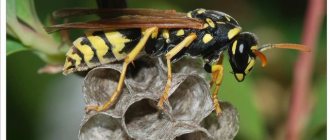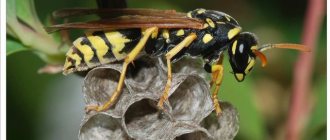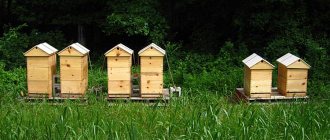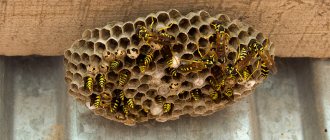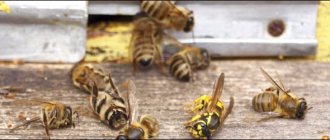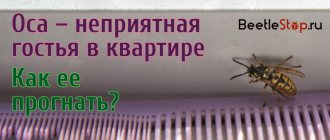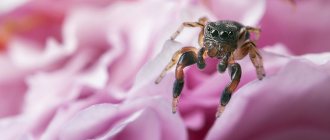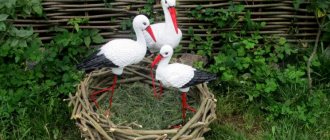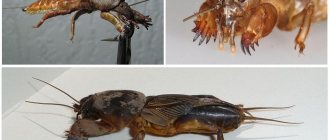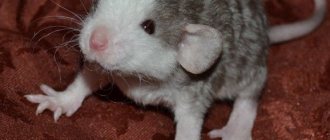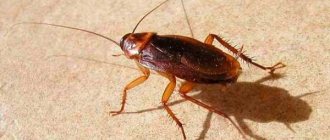On about a third of wasp extermination trips, we encounter situations where there are really a lot of wasps in the area; the owners even try to track their movements and find the nest, but the nest itself is not found simply because they do not know what it might look like. Usually people look for characteristic spherical wasp nests that they saw somewhere in a photo, in some films, or even cartoons, similar to something like this:
...and if they don’t find exactly such a structure, they assume that there is no nest on the site at all.
And then one of our guys comes and shows the nest, which looks completely different from the imperfect photos on the Internet, and definitely not like in the Disney cartoons. The nest is destroyed, and no wasps remain in the area. But so that you understand what such a nest looks like, we will show you such examples and describe various unique cases. As our practice shows, wasps are great masters of settling in places where a person will not look until the last minute, and where their nest will look like... will not look like anything at all!
But first, the classics:
Where do wasps nest?
The young queen chooses a place where there is building material and food supplies in close proximity. In the wild, insects make their homes on trees with a large, dense crown, under old stumps, and abandoned bird houses. However, there are cases of a hive being built under a stone, on a blade of grass. Where the young female considers it necessary to build housing, the working individuals will continue the construction.
Insects can build hives near humans - under the roof of a house, outbuildings, in an attic, on a balcony, or live in a garden, yard, vegetable garden, or vineyard. And also on trees, bushes, old stumps on the site. If in the wild, wasps bring a lot of benefits, destroying harmful insects, in the territory of a garden, summer cottage, yard, they become real pests. Therefore, a person tries to get rid of wasp nests on a balcony, in a country house, or in a vineyard.
On a note!
It's very easy to anger a wasp. A few sharp movements are enough for her to rush to attack. During an attack, it makes special sounds - signals, warns other members of society about the danger, and also calls for help. If there is a nest nearby, a whole swarm can attack a person.
Fighting methods
To get rid of a wasp nest on a plot of land, it is filled with boiled water or doused with a flammable substance and set on fire. The procedure is performed late in the evening, when all family members are gathered and are going to spend the night, or early in the morning, when they have not yet had time to fly away.
When placing the hive under the roof of a house, in an attic, or in a tree, the nest is immersed in water. Fill the bucket, bring it carefully to the wasp’s nest, and immerse it in water. Another modern way to get rid of pests is using a vacuum cleaner. They pull the insects into the bag at full speed, then throw them into the water.
To prevent the construction of nests, repellent plants are planted on the land - mint, lemon balm, marigolds, calendula. The walls are treated with an insecticidal substance, paint, varnish, and boric acid solution.
Construction material
The finished wasp nest is nothing short of impressive. From the outside it looks like a smooth, oval-shaped egg. Inside, numerous honeycombs are found, arranged in a certain way. The building material resembles ancient parchment. Mostly gray, brownish in color. Because of the way wasps build their nests, they are called paper wasps. The family is one of the most numerous and includes species and subspecies.
What wasps make nests from and how building materials are obtained also deserves respect. The insect lands on wood, spits out a certain amount of its own secretion, under the influence of which the upper tissues of the tree bark liquefy. The wasp grabs the top layer with its powerful jaws and pulls it towards itself, as if scraping it off. When she has the amount she needs, she goes to a place where other relatives are making a hive.
Having arrived at the right place, the wasp once again carefully chews the building material with its jaws. Under the influence of saliva, the wood becomes sticky, stringy, gray or brown, depending on what tree it was extracted from. The wasp spits the finished building material onto the already formed honeycombs, again stretches it with its jaws, giving its structure an oval shape. This is how a new thin partition appears.
Interesting!
The wasp obtains woody elements from the bark of various trees, stumps, fences, and wooden outbuildings. If there is not enough building material or the queen finds a place suitable for raising larvae, the wasps build a nest underground, in old stumps, hollows, left by bird houses.
Lifestyle
The rules for the existence of hornets in nature are very similar to those of bees and ants. In order to survive during the cold winter and give birth to offspring every year, insects have to sacrifice someone and something. They sacrifice males, who die soon after mating. This way resources are not wasted on already “useless” individuals.
After all, in the hornet family, the females are the main ones. Therefore, they must prepare well for hibernation, survive it, and in the spring become the founder of a new colony. The uterus needs a large amount of protein to produce eggs and develop ovaries. In order to successfully overwinter, it eats very richly and accumulates a fat body.
Mating Features
The greatest activity in the hornet family is observed at the end of the warm period of the year, namely the end of August and the beginning of September. By this period, individuals of both sexes become adults. They all leave their home, swarm and mate. Thus, mating occurs before the onset of cold weather. Female hornets spend the winter pregnant.
Males die soon after mating. Females lead a solitary lifestyle. They feed heavily, and between meals they fly around the nearby territory in search of a safe place for winter shelter. Overwintering of a pregnant female hornet, which falls into suspended animation, is possible only in a secluded place where enemies and cold winds will not find her.
Wintering conditions
Crevices in rocks, tree hollows, shelters under stones and fallen trunks, and small cavities on the outside of unheated buildings or houses are well suited for this. There is no need to be afraid that the female will hide inside a human house. There's a good reason for this. When cold weather sets in, when the air temperature drops below 0 0 C, all water freezes.
But the water in the hornets does not freeze. This is due to the fact that in the body of insects, water is replaced by glycerol. It does not freeze, but it slows down all life processes. This way, the glycerin cannot turn into ice and rupture the insect cells. If the hornet warms up prematurely, it will die during the next cold snap.
When the female hides for the winter in a heated human house, the warm air temperature will contribute to her premature awakening and the natural need to build a nest. If she manages to hide in a house from human eyes, then it will be very difficult for her to look for material to build the honeycomb of her “house”.
When she manages to build a nest, she will not be able to find enough food in the house to feed her offspring. Thus, she will doom him to certain death. Therefore, female hornets do not choose heated human houses for wintering.
A lot of female hornets die during harsh winters with little snow, as well as in the presence of winter thaws. If the female does not manage to hide well, she will become prey to various birds or small predators. Therefore, a significant number of hornets do not survive until spring.
Construction process
A fertilized young female, the queen, chooses a place for her future home. It glues an adhesive substance extracted from wood to the base, stretches it, and a leg is formed, on which the first honeycombs are subsequently built. Initially there are very few of them; they are necessary for growing and feeding the larvae.
The process begins in early spring. Within a month, a new generation of worker wasps appears and begins active construction of the hive. The uterus sheds the powers of an architect and is engaged only in the reproduction of offspring.
- The hornet's nest is being built at an accelerated pace, since the number of members of the large family is rapidly increasing. New cells appear at the base of the handle, which overlap each other to form a honeycomb.
- As the number of cells increases, a bowl-shaped structure begins to emerge. Over time, it increases in depth, expands on all sides, and becomes like a sphere. There is a hole in the center for entry.
- The construction of the second part of the sphere gradually begins. The number of cells decreases towards the top. The finished large wasp nest resembles a cocoon.
After construction is completed, the queen removes several layers of internal cells in the first sphere. As the wasps make the honeycombs wider, the space inside is freed up. The outer shell of the nest is thin and papery. It is formed from long, thin, elastic plates. In most cases, recycled building material is used, which is taken after the inner layers of the hive have been destroyed.
Lifestyle, main functions
The behavior of a fertile female and the lifestyle of different species of the wasp family differ, but the main mission - prolongation of the genus - remains the same.
Single queens
They are active in early spring – the mating season begins. Eggs begin to be laid in summer. Before this, they live for their own pleasure - collecting nectar from plants, drinking juices of fruits and berries. They do not form multi-tiered nests; they dig holes in the ground for laying eggs.
The queen prepares the nest in light, easy-to-digging soil. The depth reaches 5 cm; a single cell is located at the bottom.
The female paralyzes the larvae of large beetles, spiders, and various insects, drags them into a hole, and lays an egg on the body. After a few days, a larva appears and devours the victim within 14 days.
In this way, the queen provides the larva with separate housing and food. At the end of the cycle, pupation occurs. In the pupal state, the larva overwinters; in the spring, young females and males independently emerge to the surface, and the mating process begins.
Public vespins
The Wasp Queen is the founder of a large family, within which there is a clear hierarchy. The majority of the society consists of working individuals - immature females. They build a nest, provide protection, look for food, and feed the larvae.
Queen wasp of public vespins
The young queen lays the foundation of a nest in a favorable location. Initially forms a leg, then lays out the honeycomb. An egg is laid in each cell. After 3-4 days, sedentary larvae appear, which need to be fed for 2 weeks. The queen hunts spiders and insects, since the cubs require protein food. Chews, forms balls, gives to larvae.
At the end of the cycle, the larva pupates, after 2-3 days a working individual appears, to which the queen entrusts all responsibilities for building the nest, searching for food, and caring for the larvae. She herself becomes the queen of the family, only laying eggs.
In August, large honeycombs are built near the nest, where special eggs are placed. From them a generation of young sexually mature females and males appears. They live in the nest for some time, come out in the fall, and mating occurs. With the onset of cold weather, working individuals die, females find refuge in wood for wintering.
According to some sources, the former queen dies in November, according to others, she hides and spends the winter. Forms a new family in the spring and has the ability to return to its original places. From here the queen's life expectancy is calculated from 1 to 2 years.
Paper sheets
They occupy an intermediate place between primitive solitary wasps and social vespins. There may be several mature queens in one nest, but only one plays the role of queen. The rest help her increase the population size. The number of hives reaches several hundred individuals. Otherwise, the functions of the uterus are identical to vespins.
Paper wasp queen
In nature, there are many species, subspecies, and genera of wasps. Among them there are predatory queens or parasites that sneak into someone else's nest, kill the true queen, and take her place. The enslaved family cares for the larvae of the new queen, feeding her herself. Over time, only her offspring remain in the hive.
What does a wasp's nest look like from the inside?
The interior structure is funny, thoughtful, surprising. The honeycombs are placed vertically in unique floors, after every 3-6 rows there is free space. It is also surprising that all the cells are directed downward in one direction. A cross-sectional photo of a wasp nest can be seen below. You can cut the hive only if you are absolutely sure that it is empty.
Interesting!
The average typical structure of wasps is no larger than the size of an apple. In some cases, giant round wasp nests grow to incredible dimensions. They are 1 m in diameter. There are several thousand wasps in a wasp nest of incredible size, up to a million.
The structure of the hive is thought out to the smallest detail. The inner part is always the most durable and reliable. Honeycombs are not built from a thin sticky secretion similar to paper, but from wood chips, in a size that the working individuals can carry and attach. Inside the wasp nest there are chambers for larvae, a room for the queen, food storage rooms and much more.
Nutrition
Wasps are predators, but they don’t shy away from sweets, on the contrary, they adore them. Almost everyone knows that if you leave a bowl of honey or jam on the open veranda, then after a while you can find a whole flock of feeding wasps near it.
These insects collect flower nectar, but, being predators, they also eat small relatives of other species.
The predatory nature of wasps is also manifested in the fact that in order to provide their larvae with food, they can lay eggs, for example, in a large caterpillar.
The wasp pierces the skin of the caterpillar, using its ovipositor like a scalpel, lays eggs and the larvae, having hatched, begin to eat the body of the victim. Spiders, large beetles, and cicadas become such incubators.
Features of anatomy
Wasps belong to the suborder of the stalked-bellied Hymenoptera, and only by looking at the features of the internal structure of the wasp, you can understand why this order got its name. Between the belly and chest of this insect there is a rather narrow “waist”, and some wasps (species of which you can see photos above) generally have an almost invisible “stalk” instead of a waist.
Thanks to this feature, wasps are able to almost fold their own body in half, and also have the ability to sting the victim at any desired angle. Due to this, they can win fights even with some of those insects that are noticeably larger than them.
The body of the wasp is divided into three distinct segments - the abdomen, thorax and head, and it is worth noting that the body is covered with a fairly strong chitinous skeleton. The head is quite mobile, and is equipped with two antennae, which are responsible for a fairly large number of different functions, including capturing air vibrations and odors, as well as assessing the taste of liquid food or even measuring the length of honeycombs in nests.
South Polybia
The wasp family includes many species. These insects have a very wide habitat. The species Polybiinae Occidentalis (Polybia Occidentalis) is found in the southern states of the USA, Mexico and northern Latin America. These wasps are surprisingly similar in habits to hardworking bees. These insects are not just their hairy bodies. They also collect, digest and store flower nectar in honeycombs. And the question of whether there is wasp honey can be answered with confidence in the affirmative. The Yucatan Indians ate the product of processing nectar from the nests of Polybia Occidentalis long before their arrival. However, the American aborigines did not breed apiaries. They simply collected honey from wasp nests. This product is not as sweet as bee, but still tasty and nutritious. By the way, there is much less honey in the nest. Perhaps because in the tropical climate, Southern Polybia does not need to accumulate it in reserve.
How many wasps in one nest
Depending on the size of the house, a huge number of insects, sometimes numbering in the hundreds of thousands, can comfortably live in it.
Wasps are distinguished by a variety of species of individuals living in interaction in one house. Females, males and working insects have different structures and external differences that are noticeable even to a non-specialist. Each group strictly fulfills the duties prescribed by nature. Differences within one species are called polymorphism, or multiformity. The bulk of the residents are working individuals, which are concentrated around the queen, who continues to lay new eggs.
External differences of insects
In most cases, comparisons of different insects begin by examining their appearance. It identifies certain features that are characteristic of a particular individual. Based on these characteristics, you can easily determine what species a creature belongs to.
Wasps
A wasp is a stinging insect of the order Hymenoptera. There are dozens of species of these creatures, which are divided into two broad categories: solitary and social wasps. The former prefer to live as hermits and rarely build nests for themselves. Social insects create families, the number of individuals in which can exceed 1,000.
Traits characteristic of most wasp species:
- size – from 2 to 5.5 cm;
- the body structure is distinguished by the presence of a waist;
- elongated body shape;
- the body is smooth and covered with many hairs;
- bright yellow-black color;
- striped posterior segment of the body;
- the presence of five eyes (2 lateral and 3 vertex);
- smooth and short sting.
Executioner wasp: bite and its consequences, where it lives and what the insect looks like, read more in this article.
Bees
The bee is a honey-bearing insect belonging to the suborder Stalked-bellied and the order Hymenoptera. More than 20,000 species of these creatures live in nature, which can be found on all continents except Antarctica.
Appearance Features:
- the size of individuals is from 2.1 to 39 mm;
- a shaggy body that does not have a pronounced transition from the chest to the abdomen;
- pale color with black and yellow stripes;
- the back and paws, covered with many hairs, are painted black;
- long proboscis (1.7 mm);
- short antennae consist of 12–13 segments;
- two pairs of wings (the front ones are longer than the back ones);
- the sting is smooth, with a small notch at the end.
Hornets
Hornets are a genus of large insects from the family of Foldoptera wasps. They live in the northern hemisphere, but are also present in small quantities in the southern hemisphere. On the European continent, only the common hornet is found, which has been able to adapt to harsh environmental conditions.
External differences:
- body length – up to 55 mm;
- color – black and yellow stripes (sometimes there are orange or brown individuals);
- wide crown of the head;
- the abdominal cavity at the back of the waist is slightly rounded;
- two pairs of long wings are located along the back;
- three regular and 2 compound eyes;
- the jaws are colored black, orange or brown;
- the sting is smooth and hollow inside.
bumblebees
A bumblebee is an insect from the family of True bees. Biologists know more than 30 species of these creatures. The ability to adapt to new environmental conditions allows bumblebees to thrive on all continents except Antarctica. They live not only on flat terrain, but also in the mountains.
The main differences between the bumblebee and other hymenopteran insects:
- bright color consisting of red and brown stripes;
- the body is covered with a large number of long hairs;
- size from 7 to 28 mm;
- shiny hind tibia;
- the abdomen is not tucked at the apex;
- presence of the sixth abdominal sternite;
- small transparent wings;
- short hollow sting.
Interesting! Bumblebees have a unique ability to regulate their body temperature. This helps them tolerate cold well and cope with extreme heat.
How long do wasps live in a nest?
After the wasps have built a nest, the life cycle of the wasp family lasts one summer. The life of the hive, which began in the spring, reaches its climax by mid-summer and continues while construction is underway. By the beginning of autumn, all life processes calm down and stop. The established order is unchanged and requires annual new buildings.
Last year's hives are not relevant for a wasp swarm, but if the location chosen for construction is well located, the insects will build another home within walking distance of last year's house.
Important! Wasps can return to their favorite places even after their home is destroyed. Therefore, it is necessary to treat the area where the hive is located with special substances designed to combat and destroy these insects.
Mechanical disposal
How to remove a beehive from a balcony? What to do if wasps have built a nest under the roof? To do this, there are several effective methods that can be used to quickly destroy a wasp nest and remove them from the house. Prevent these insects from coming back. First, you can protect yourself from the harm they can cause.
Hands can be protected with long rubber gloves, and clothing should be tight and as closed as possible. You can protect your face with a special beekeeping hat with a mesh, or come up with your own homemade version.
If it is noticed that wasps make their home in the spring, early summer, then it is not recommended to debug their destruction until later, when their colony becomes numerous and it will be difficult to find out how many wasps are in the nest.
Fire
Fire should only be used as a last resort. Everything is done quickly and efficiently. Wear protective clothing, wait until dark, take a bucket, kindle, matches, and approach the nest from a safe distance. When you are completely sure that these insects are sleeping, you can begin to neutralize this colony.
To carry out everything safely, you can take an unnecessary rag, throw it over the cocoon, throw it into a bucket, quickly set it on fire, and then move some distance away, since some individuals can fly out and behave aggressively.
Water
They remove the wasp nest using water, mainly on the balcony. There are two ways to do this: the first method requires boiling water, the other you can simply put plain water in a bucket. You can throw a plastic bag over it and destroy the hive in water by immersing it completely, while pressing it down with something heavy so that it does not float up and the wasps do not get out.
Everything should be done quickly. You cannot leave these insects in the bag for a long time - they can chew through the polyethylene and get out. It is best to remove this bucket from the house immediately.
Traps
How to destroy a wasp nest under the roof? This is very difficult to do with the help of fire, water, access to it is difficult. Then you can destroy the wasp hive using special traps. There are such options on sale, or you can make them yourself. Using this method, you can lure them out of the hive and destroy them by falling into a prepared trap.
What to do if wasps have built a nest under the roof - use this ideal option. It won't be hard to do it yourself:
- To do this, prepare a clean plastic bottle.
- Its neck needs to be cut off along with a small part of the bottle, placing it in it with the back side.
- To prevent the neck from falling inward, you can secure it to the bottle with tape.
- Wipe the walls of the trap with sunflower oil so that individual individuals cannot get out.
It is necessary to place bait in this trap, which will attract wasps to it by the smell carried around. In early spring, it can be prepared from meat waste and offal, but it is worth remembering that such a “delicacy” has an unpleasant odor. In summer and autumn, you can pour sweet syrup into a bottle, which attracts wasps into it.
Don't use honey - it will attract bees. The bait in the trap must be changed regularly, washed, filled, and filled with new bait. As they decompose, dead individuals release an odor that repels the living.
It is worth remembering that catching all the individuals is difficult, time-consuming, and unsafe, but if you manage to lure the queen into this trap, then it will be easier to destroy the colony, and removing a wasp nest on the balcony will be much easier.
It can only be lured in early spring - it is not so active or aggressive. There are special traps on sale that have poisonous bait. It needs to be changed as it becomes filled with insects. Due to the chemicals it contains, it must be hung away from your own home.
Vacuum cleaner
There is a simple option - remove the hive using a vacuum cleaner. This can only be done if the vacuum cleaner is a washing model. Pour soapy water into the reservoir, make sure that the hose is long enough and the grille is shallow, which will prevent insects from flying out.
Carefully bring the end of the hose to the hole in the socket and turn it on. If they get into water with soap, it will be difficult for them to get out and they will die there. Before you remove a wasp's nest in your dacha, be sure to make sure that no one is left there, all its inhabitants have died.
When wasps leave their nests
Every hive has guard wasps. When danger approaches, they give a special signal, thanks to which a large number of irritated insects instantly emerge from the nest, ready to defend their possessions.
Despite the fact that the wasp's venom does not pose a critical danger to humans, its bite is quite painful. The most powerful and unpleasant bite for humans is a hornet bite.
Important! A distinctive feature of all wasps is the ability to sting several times in a row. Due to its structure, a wasp sting does not get stuck in the skin of a person or animal.
Close proximity to a wasp nest can ruin not only the mood of people living nearby, but also their health. Therefore, having discovered a hive, it is necessary to take decisive measures to destroy it. With quick and precise movements, crush the hive with your hand or, if possible, your foot.
Attention! Having decided to destroy a nest, you need to protect your body, especially your face and hands, with clothing that can protect you from bites.
Brachygastra lecheguana
The folded-winged family, which includes wasps, is very numerous. Among them there are also predators, pollists. Unlike our yellow-and-black wasps, they lead a group lifestyle, and in a swarm they have clearly assigned responsibilities. Like a bee hive, pollists have a queen that lays eggs, drones, and many worker wasps: builders, hunters, and larval guards. But among the predatory species there is a honey-bearing species. It is called Brachygastra lecheguana. These wasps live in the United States, their habitat extends to southern Texas. Their honeycombs are very unusual: they are covered on the outside with a paper cover. Like all Polites, they also feed on insects, but they deposit wasp honey in their nests. About fifteen thousand individuals live in one such swarm. This type of wasp likes to make nests in the crowns of citrus trees. The “bee” lifestyle of the Brachygastra species is all the more surprising because their ancestors were exceptional meat eaters.
Beekeepers know that the bee's stomach contains special enzymes. They are responsible for the fact that tasty and sweet honey is obtained from nectar and pollen. Wasps do not have such enzymes. However, the Indians of Latin America did not know sugar cane (and especially white beets) before the arrival of Europeans on the continent. Their only sweetener was honey produced by the wasp species Polybia Occidentalis. It is very fragrant, but crystallizes quickly because it is pollen with flower nectar. Since the production of honey in wasps is different from that of bees, the properties of poisonous plants are transferred to the product. Thus, nectar and pollen from dope can cause serious poisoning in humans. But Polybia Occidentalis, a honey-bearing species. If you care for these insects, they can produce more product than they need for their livelihoods.
Wasps - masters of paperwork
Among all the species that inhabit our planet, wasps are characterized as the most skilled paper crafters .
True, not all wasps build their magnificent houses from paper pulp, which is obtained by chewing wood. However, the well-known striped robbers, which many people with a sweet tooth have been afraid of since childhood, belong specifically to the family of so-called paper wasps, or more precisely to two biological families, similar in biological characteristics - vespins and polystines.
The wasps of these two families lead a social lifestyle, which forces them to build rather large nests that would provide shelter to all members of the wasp community. At the same time, the multi-apartment wasp house must be dry and warm, because, like all hymenoptera, wasps are afraid of high humidity, which weighs down their transparent porches and does not allow them to take off.
Alcoholic cocktail dessert
Experienced baristas know how to make “wasp honey” with their own hands. To do this, you need to beat four egg yolks and add them to a can of condensed milk. Continue using the mixer until the mixture is airy. After this, mix a spoonful of instant coffee with a very small amount of boiling water (so that the granules disappear). Stir in the milk-yolk mixture. Pour in a thin stream one hundred milliliters of alcohol (this dessert is eaten with a spoon) or a glass of vodka (the cocktail is served with a straw). Place the finished product in the refrigerator for an hour.
Having waited until nightfall, dressed in closed clothes, he did everything as Nikolai Ivanovich said. In this article you will learn: how to remove a wasp nest, what are considered safe methods of control, what drugs and traps are best to use, and how to prevent their reappearance.
Paper is an ideal building material
Of all the building materials, paper turned out to be the most suitable for wasps. By absorbing excess moisture and being breathable and warm, it ensures the “combat readiness” of all wasps living in the nest, even in unfavorable conditions of high humidity and relatively low temperatures.
And this is an extremely important task. After all, wasps consume quite a large amount of food compared to other insects, and in addition, they constantly need animal protein in order to maintain their existence.
Nest growth
After making the base of the nest, the female flies in search of building material. Having found suitable wood, she releases a drop of saliva onto it, which softens the wood fibers. The wasp scrapes off the pliable wood using its powerful jaws and rolls it into a small ball with its front paws. Moving along a woody surface like a precise mechanism, the wasp leaves behind a clearly visible trail.
The female carries the resulting lumps to the construction site. There she chews the wood again, mixing it with saliva and secretions of special glands. From the material, which becomes completely soft, the wasp makes a paper plate, carefully and evenly kneading the parchment lump with its front paws. The wasp attaches the resulting piece of paper to the base of the nest and flies for a new portion of material.
While building the frame, the female simultaneously lays eggs and feeds the growing larvae. The newly matured wasps join the construction. As soon as the female manages to raise 10 new wasps, she stops building and from that time on only lays eggs, then her children build the nest.
Wasps wintering place
Looking at the internal and external structures of the wasp’s nest, it seems that the family will spend more than one year there. Similar to what happens in ants. However, large buildings and complex architectural structures play the role of a summer house.
With the onset of autumn, young sexually mature females mate and begin to look for a suitable place for wintering - cracks in the wall, wooden buildings, tree bark, old stumps, abandoned hollows. Over time, metabolic processes slow down, the female falls into suspended animation and sleeps until the beginning of spring. From the first warm days he begins to build a new hive.
On a note!
The remaining members of the family die from the cold in the fall or become victims of natural enemies. They lose their previous activity, become slow and vulnerable. At the end of the season, the old queen, workers, and males die.
Reproduction and lifespan
The queen, well-fed after hibernation, makes the first clutch of eggs in the spring. Only sterile wasps emerge from it - they are intended to continue building the nest and obtaining food.
And only at the end of summer are eggs laid, from which larvae emerge that are capable of reproducing in the future
When the wasps grow from the larvae, they begin to swarm, mating with each other. As soon as fertilization has occurred, pregnant females fly away from the nest one by one in search of a suitable warm winter shelter
With the onset of the cold season, the males and the entire previous swarm, led by the old queen, die. In the spring, the new queen, in turn, will build her own nest
The female wasp mates only once and brings more than 2000 larvae, most of which will become infertile - working individuals.
This clutch is sealed into a chamber with small insects left in it as future food for the larvae.
But wasps feed the larvae, from which individuals capable of reproducing will grow, differently. They are brought food that promotes the development of genital organs.
Wasps do not live very long - the life of the queen is 10 months, and the life of drones and workers is 4 weeks.
Wasps of various species live everywhere, because they can get food anywhere, but most of all they like to settle next to human habitation - because here you don’t have to make much effort to find food.
Who destroys wasps' nests
In addition to people who do not like living next to wasps, their houses are often destroyed by wild animals and birds. It is especially common to see tits pecking at last year’s wasp’s nest.
Wasp nests can become a source of discomfort and irritation for those whose home they choose as their place of stay. Therefore, it is better to take preventive measures in advance to avoid an inconvenient and burdensome neighborhood.
Source
Poisoned baits
You can also use poisoned baits to exterminate wasps; when using them, you will have to wait longer for the results, but this option is the safest in all aspects, and also does not require any skill for successful implementation.
To poison insects, you must adhere to the following instructions:
- As bait, it is best to use beer, to which additional sugar is added, or fermented jam, which has an aroma attractive to wasps. It is not recommended to use honey, since bees that do not pose a threat to humans will also react to it.
- Add any toxic substance to the bait, it can be one of the types of insecticides or just boric acid.
- The bait and the poisonous substance must be mixed well with each other, then placed on a plate and placed on an accessible and open surface. It is best to choose a place somewhere in the trees or where children or pets cannot reach the poisoned bait.
- Renew the poisoned bait every few days; this must be repeated until the insects completely disappear from the area where they were planned to be hatched.
